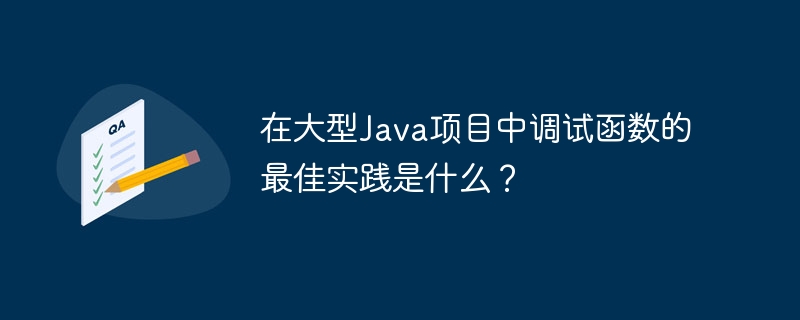Home >Java >javaTutorial >What are the best practices for debugging functions in large Java projects?
What are the best practices for debugging functions in large Java projects?
- WBOYWBOYWBOYWBOYWBOYWBOYWBOYWBOYWBOYWBOYWBOYWBOYWBOriginal
- 2024-04-24 14:42:02994browse
Best practices for debugging functions in large Java projects include using breakpoints to pause program execution and examine variable values. Step through your code line by line and see the impact. Use logging to track program behavior and provide error information. Use exception handling to catch and handle errors to prevent crashes. Write unit tests to verify function correctness and isolate problems.

#Best Practices for Debugging Functions in Large Java Projects
Debugging is a critical process for resolving software errors. It can be a challenging task in large Java projects and this article will provide you with the best practices for debugging functions in large Java projects.
1. Use breakpoints
Breakpoints are the most basic and most powerful tool when debugging. They allow you to pause program execution at specific lines of code so you can examine variable values and program status. In Java, you can set breakpoints using the debugger keyword or the debugger interface.
2. Single-stepping
Single-stepping allows you to execute program code line by line and examine the impact of each line. This is useful for tracking complex logic and understanding variable changes. In Java, you can use the "Step into" button of the debugger interface.
3. Use logging
Logging is another valuable tool for tracking program behavior and providing valuable information when problems arise. You can add logging statements to your code to indicate the values of key variables or the progress of your program. This helps identify problems when errors occur.
4. Exception handling
Exception handling is a structured mechanism for managing program errors. By using try-catch blocks, you can catch exceptions and handle them, preventing your program from crashing and still providing useful information.
5. Unit testing
Unit testing can not only verify the correctness of the function, but also help isolate problems. By writing unit tests that target specific functions, you can detect errors early and prevent them from spreading to other parts of the project.
Practical Case
Consider the following function, which counts the number of distinct elements in a given array:
public static int countUniqueElements(int[] arr) {
HashSet<Integer> uniqueElements = new HashSet<>();
for (int element : arr) {
uniqueElements.add(element);
}
return uniqueElements.size();
}If the array contains duplicate elements, the The function will not correctly count the number of unique elements. In order to debug it, we can use the following best practices:
-
Set a breakpoint: Set a breakpoint at the
uniqueElements.add(element)line to check Added elements. -
Single-step execution: Step through the code and observe how each element is added in
uniqueElements. -
Using logging: Add a logging statement to print each element added to
uniqueElementsto help identify duplicate elements.
Using these best practices, you can effectively debug functions and resolve errors in large Java projects.
The above is the detailed content of What are the best practices for debugging functions in large Java projects?. For more information, please follow other related articles on the PHP Chinese website!

